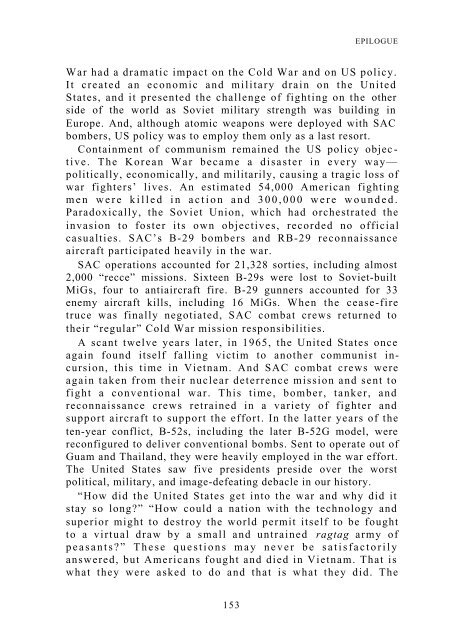You also want an ePaper? Increase the reach of your titles
YUMPU automatically turns print PDFs into web optimized ePapers that Google loves.
EPILOGUE<br />
<strong>War</strong> had a dramatic impact on <strong>the</strong> <strong>Cold</strong> <strong>War</strong> and on US policy.<br />
It created an economic and military drain on <strong>the</strong> United<br />
States, and it presented <strong>the</strong> challenge of fighting on <strong>the</strong> o<strong>the</strong>r<br />
side of <strong>the</strong> world as Soviet military strength was building in<br />
Europe. And, although atomic weapons were deployed with SAC<br />
bombers, US policy was to employ <strong>the</strong>m only as a last resort.<br />
Containment of communism remained <strong>the</strong> US policy objective.<br />
The Korean <strong>War</strong> became a disaster in every way—<br />
politically, economically, and militarily, causing a tragic loss of<br />
war fighters’ lives. An estimated 54,000 American fighting<br />
men were killed in action and 300,000 were wounded.<br />
Paradoxically, <strong>the</strong> Soviet Union, which had orchestrated <strong>the</strong><br />
invasion to foster its own objectives, recorded no official<br />
casualties. SAC’s B-29 bombers and RB-29 reconnaissance<br />
aircraft participated heavily in <strong>the</strong> war.<br />
SAC operations accounted for 21,328 sorties, including almost<br />
2,000 “recce” missions. Sixteen B-29s were lost to Soviet-built<br />
MiGs, four to antiaircraft fire. B-29 gunners accounted for 33<br />
enemy aircraft kills, including 16 MiGs. When <strong>the</strong> cease-fire<br />
truce was finally negotiated, SAC combat crews returned to<br />
<strong>the</strong>ir “regular” <strong>Cold</strong> <strong>War</strong> mission responsibilities.<br />
A scant twelve years later, in 1965, <strong>the</strong> United States once<br />
again found itself falling victim to ano<strong>the</strong>r communist incursion,<br />
this time in Vietnam. And SAC combat crews were<br />
again taken from <strong>the</strong>ir nuclear deterrence mission and sent to<br />
fight a conventional war. This time, bomber, tanker, and<br />
reconnaissance crews retrained in a variety of fighter and<br />
support aircraft to support <strong>the</strong> effort. In <strong>the</strong> latter years of <strong>the</strong><br />
ten-year conflict, B-52s, including <strong>the</strong> later B-52G model, were<br />
reconfigured to deliver conventional bombs. Sent to operate out of<br />
Guam and Thailand, <strong>the</strong>y were heavily employed in <strong>the</strong> war effort.<br />
The United States saw five presidents preside over <strong>the</strong> worst<br />
political, military, and image-defeating debacle in our history.<br />
“How did <strong>the</strong> United States get into <strong>the</strong> war and why did it<br />
stay so long?” “How could a nation with <strong>the</strong> technology and<br />
superior might to destroy <strong>the</strong> world permit itself to be fought<br />
to a virtual draw by a small and untrained ragtag army of<br />
peasants?” These questions may never be satisfactorily<br />
answered, but Americans fought and died in Vietnam. That is<br />
what <strong>the</strong>y were asked to do and that is what <strong>the</strong>y did. The<br />
153
















